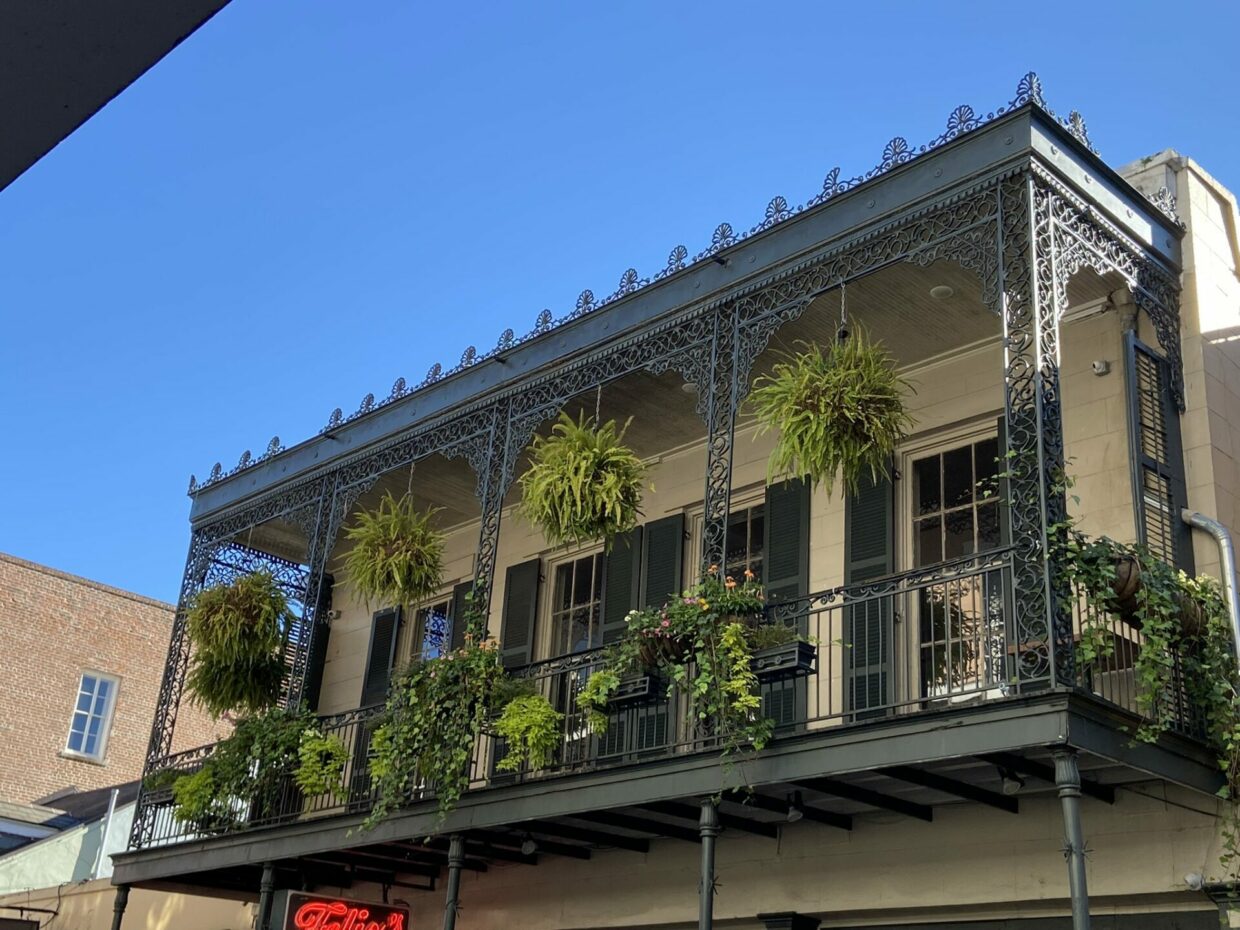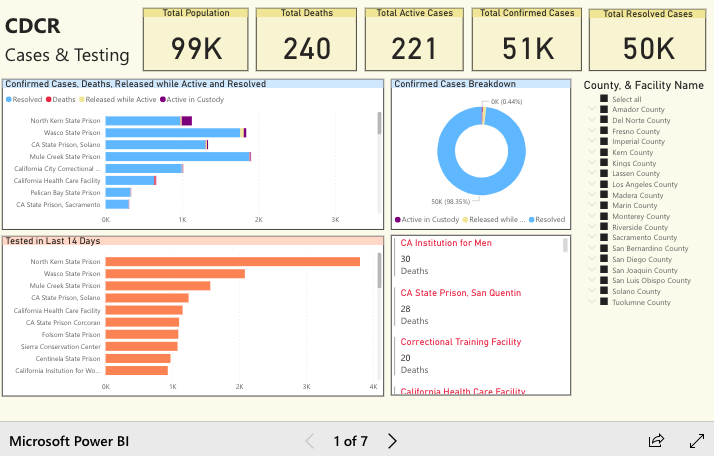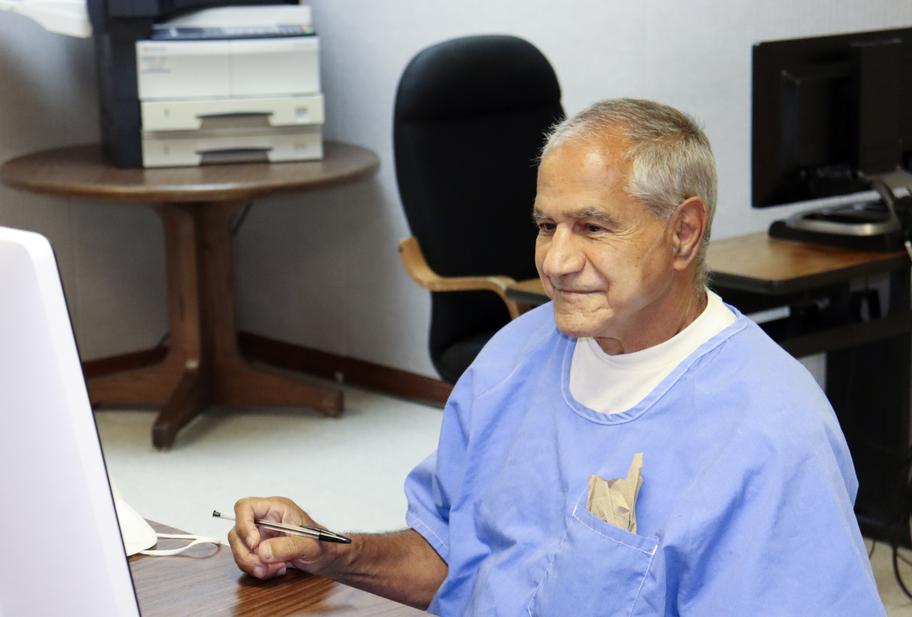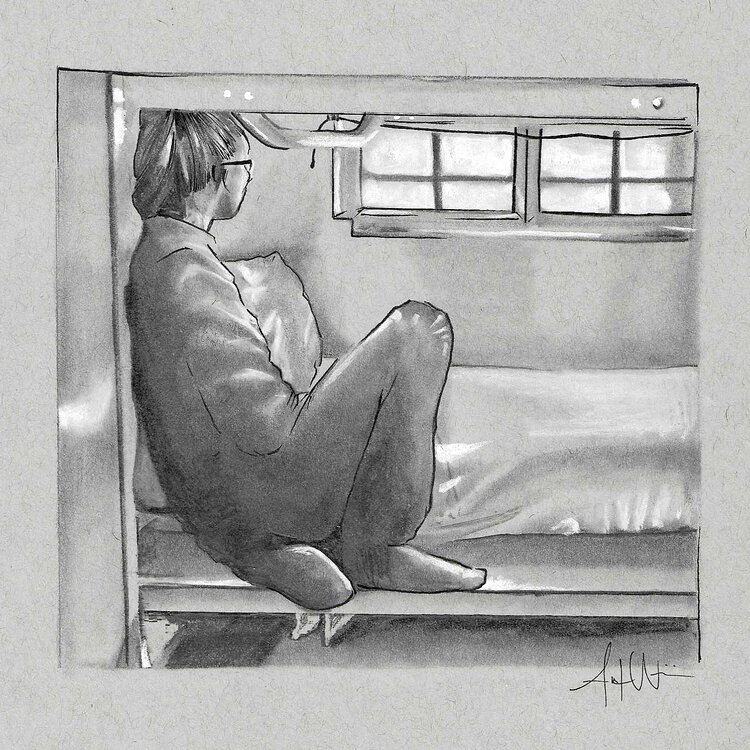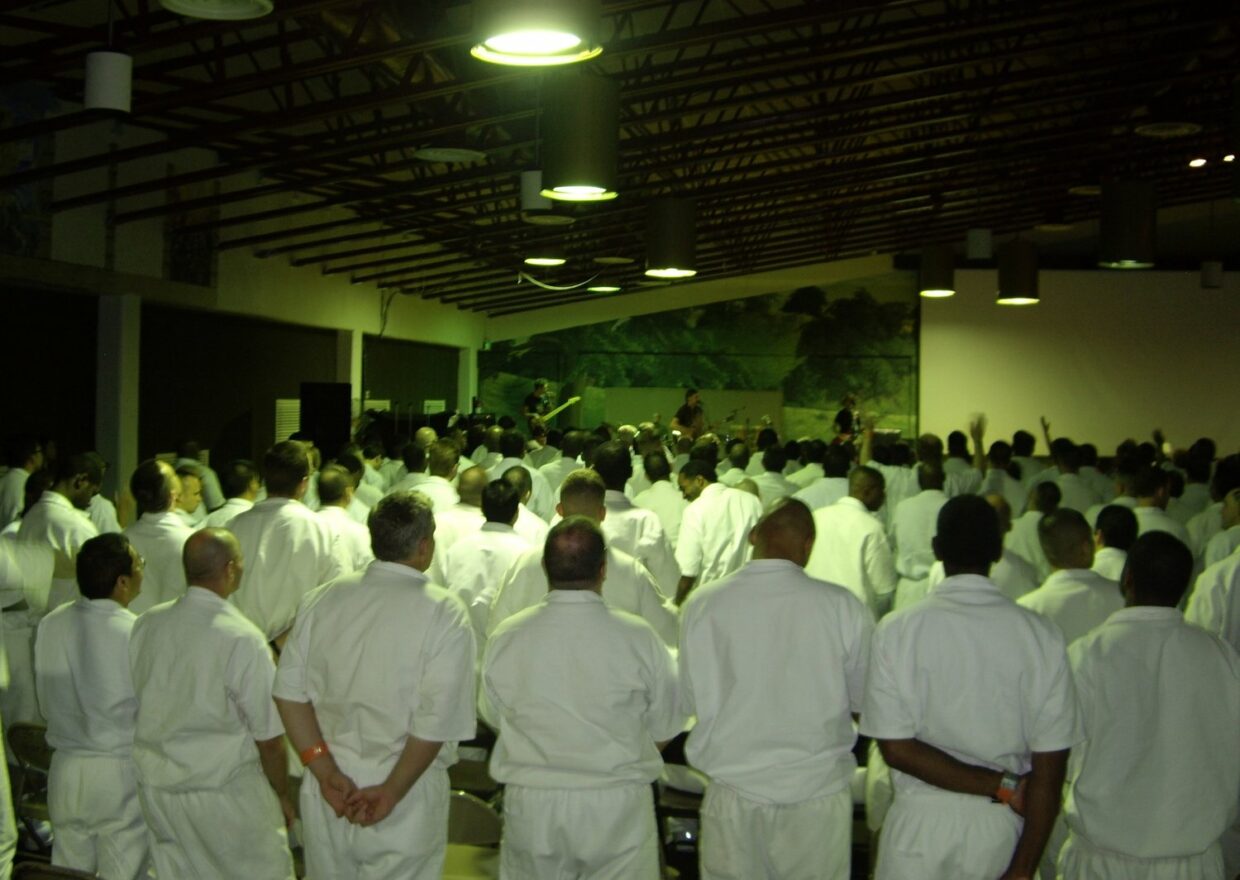For the first time since Fall 2019, I got on a plane on Monday and flew to New Orleans; Professor Adam Feibelman very graciously invited me to participate in the Workshop on Law and the Economy, and I had the opportunity to present Fester to people who read big chunks of it, including the introduction and Chapter 4.
Continue readingWhat is the CA Attorney General’s Job?
On July 9, 2020, the #StopSanQuentinOutbreak coalition held a press conference outside the prison gate to draw attention to the medical crisis behind bars. The five weeks that preceded the conference saw the COVID-19 case count in the facility grow from zero to more than a thousand, and when we held the conference, people were already dying. Many people spoke at the conference–family members, formerly incarcerated people, doctors, experts, politicians.
The picture above is from the press conference. On the right side of the picture is then-Assemblymember Rob Bonta, who spoke very movingly and urgently about the need to have Gov. Newsom visit the prison and release people. Bonta’s speech was quoted in the Guardian:
“We are in the middle of a humanitarian crisis that was created and wholly avoidable,” said the California assembly member Rob Bonta at a press conference in front of San Quentin state prison on Thursday.
“We need act with urgency fueled by compassion,” he added. “We missed the opportunity to prevent, so now we have to make things right.”
Fast-forward a year and a half, and Bonta, now California’s Attorney General, is appealing Judge Tigar’s order to vaccinate the guards in CA prisons. The staunch resistance at CDCR and at the Governor’s mansion to the idea of letting old, sick people be released back to their families–purely for optics reasons, as they pose little to no risk to public safety–resulted in a paltry an ineffectual release policy (as I predicted the day it was announced) and, also predictably, in a complete abandonment of the release plan as soon as vaccination emerged on the horizon. Within the activist/advocate community, this presented a problem: while vaccines would slow down, or even end, the COVID-19 crisis, they would not prevent future contagions, which are sure to come given the prison infrastructure, medical understaffing, and chronic neglect and indifference. At the time, when talking to a friend, I said we had to get on the vaccine bandwagon; the fight to save lives now was as important as the fight to save more lives in future years, and we certainly could not afford to let go of the call to make the prison population a top vaccination priority.
Despite some governmental hiccups, and despite the prevalence of ignorant arguments that combined deservedness with medical care, people in correctional facilities educated themselves about the benefits of vaccination and, thankfully, accepted the vaccine at rates exceeding the general population. The credit for this success goes first and foremost to the correctional residents themselves, who had to sift their way through mountains of disinformation from custodial staff and their own mistrust of anything coming out of the authority that caused the outbreak in the first place. It also goes to formerly incarcerated people who encouraged their friends to do the right thing, and to AMEND for targeting correctional populations with excellent, 100% reliable medical advice. It certainly does not go to the government, which deprioritized prisons throughout the process.
More seriously, the staff is still the problem: custodial staff nationwide are still refusing vaccines at mind-boggling rates.
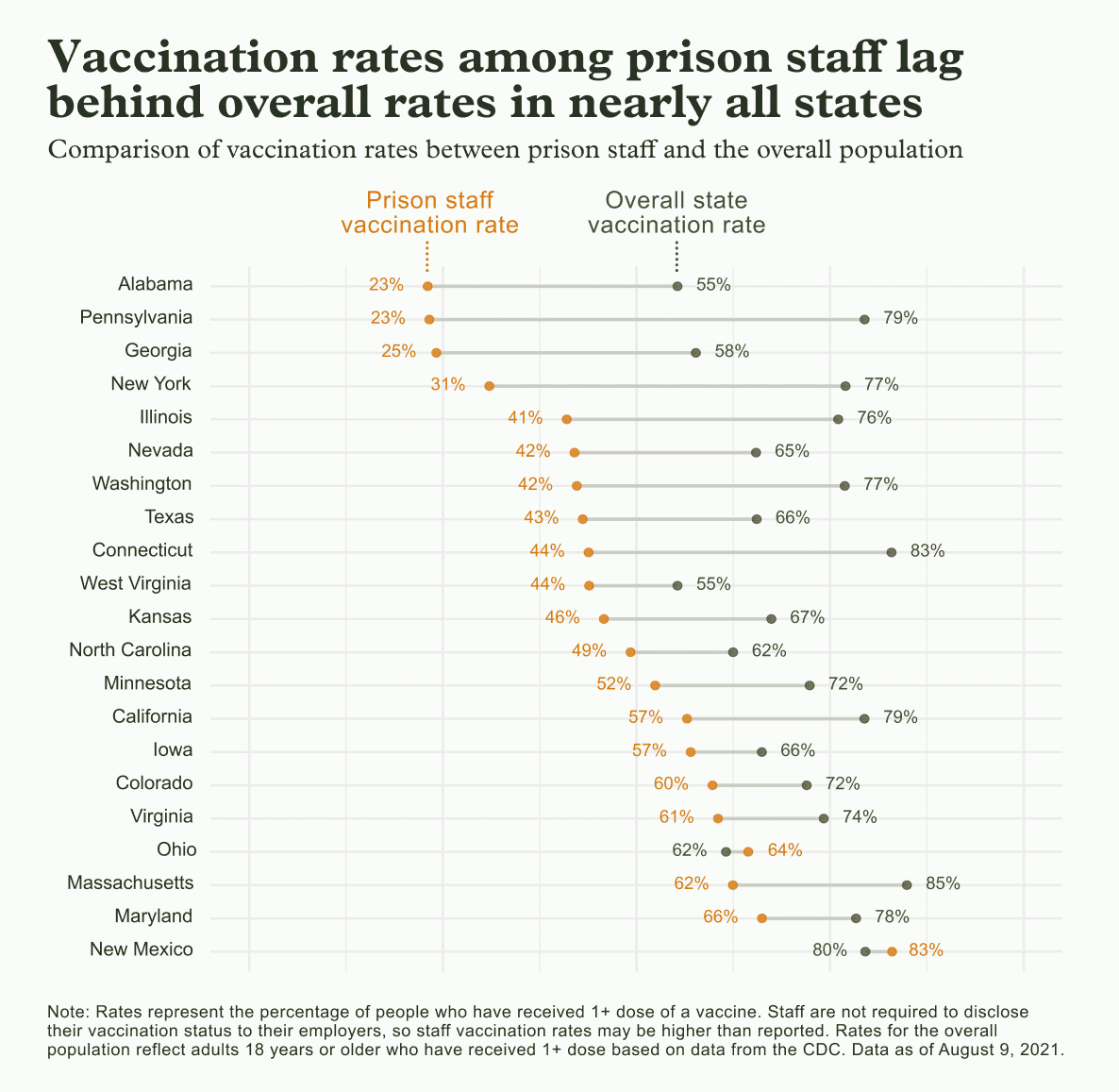
In short: Even though the fight to release people is still as urgent and relevant as it was in the summer of 2020, virtually nothing has happened on that front that would make a difference during this pandemic or the next one. Jail populations are back up to pre-pandemic levels; California prisons, which are still overcrowded despite a 18% population reduction, are now responsible for 7 out of the top 10 largest COVID-19 prison clusters in the country.
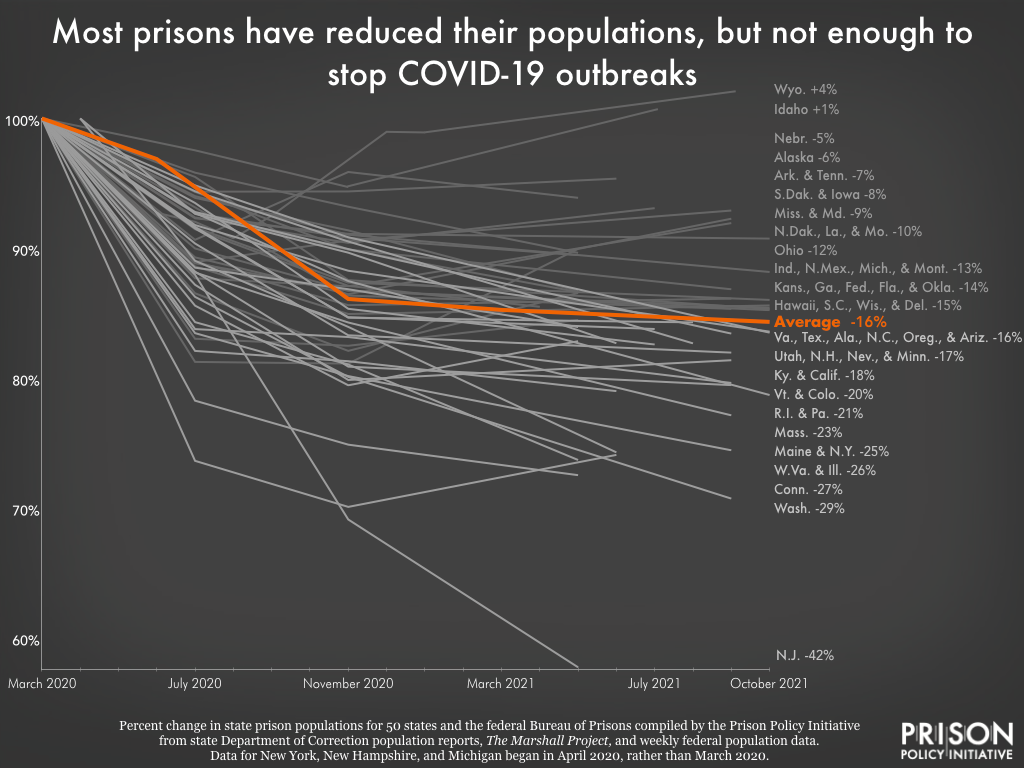
Against this backdrop–the most important and pressing measure for contagion prevention basically abandoned–the litigation battle lines have been drawn at a much more modest expectation: staff vaccination. As a legislator, Bonta called for the more thorough system fix; as part of the Newsom administration, his employees are defending indefensible arguments and making absurd excuses to shirk responsibility even for the truly modest goal of protecting the lives of staff and incarcerated people.
Bonta/Newsom’s zealous appeal against this modest goal (essentially an incomprehensible support of Trumpist anti-vaccine drivel coming out of the Proud Heroes of the Resistance! or is it?) is even more absurd when compared to the Newsom/Bonta perspective on mandating vaccines in schools, considerably less dangerous settings than correctional facilities from an epidemiological standpoint. Indeed, some anti-maskers are calling Newsom/Bonta to task for forcing them and their kids to vaccinate when they are not imposing such duties in prison (even a broken clock shows the correct time twice a day.) Bonta’s response when a CalMatters journalist confronted him with the hypocrisy? “I have a client” (i.e., CDCR) and “you’ll have to take it up with my client.”
Which brings up an important question: What, actually, is the Attorney General’s job? Is the AG wearing two separate hats when supporting legislation/regulation and when litigating? Can the government speak out of two sides of its mouth on, essentially, the same matter of scientific/medical validity? When litigating in court, is the AG no more than a hired gun for a “client” (the government) with no obligations to support what’s right? Does the AG stop working for us when he works for our government? When protecting anti-masker prison guards, does the AG stop being a public official, holding office for the benefit of all Californians, and become CCPOA’s Tom Hagen?
Here are two instructive scenarios from recent CA history. In the first one, then-Governor Jerry Brown and then-AG Kamala Harris were called upon to defend a new amendment to the CA constitution, otherwise known as Prop 8 (“marriage is between one man and one woman”). You may recall their position then: Harris declined to defend Prop 8 “because it violate[d] the Constitution. The Supreme Court has described marriage as a fundamental right 14 times since 1888. The time has come for this right to be afforded to every citizen.”
Let’s recap: The Eighth Amendment guarantees freedom from cruel and unusual punishment, which in the context of prison conditions means that deliberate indifference to a serious health and safety risk is violative of the Constitution. We now have a ruling that having unvaccinated staff at CDCR facilities is a violation of the Eighth Amendment. AG Bonta, why would you defend this in federal court?
In the other instructive scenario, Harris, again as Attorney General, appealed Jones v. Chappell, a federal court decision that held the death penalty unconstitutional because of the delays. At the Ninth Circuit, they prevailed on a narrow, technical ground–the district court had applied a “new rule” at a habeas proceeding (for my explanation of this technical legal point, see here.) On principle, I still maintain that it was wrong of Harris to appeal the decision (here‘s a summary of my position on that matter.) It was an illustration of a tail-wagging-the-dog scenario: Harris walked away from that incident remembered for upholding a technical retroactivity ruling, rather than for dismantling our dysfunctional and monstrous death penalty. But at least there was some doctrinal support for that position.
This is not the case here: we have a ruling that is not only correct (and extremely narrow) on a policy level, but also on a legal level. Bonta and Newsom know full well that their position is morally and legally indefensible. Why, then, are they appealing, and is this a fulfillment of the AG’s ethical obligations?
Moreover, even accepting Bonta’s peculiar distinction between his role in legislation and in “client” representation, even the most zealous and unprincipled gun-for-hire private attorney will have situations in which it will be necessary to sit down with the client and explain that a position that the latter wants to advance in court is untenable (e.g., there’s no hope for an insanity defense because the defendant is sane; there’s no self-defense because there’s ample proof that the defendant shot someone in the back for profit with no provocation whatsoever.) In situations in which the client insists on a particular line of legal argumentation, lawyers who cannot pursue that line with a straight face need to withdraw from representation. It is long past time for Bonta and his employees to have a come-to-Jesus conversation with their “clients” and explain that vaccinating the staff is a minimal, modest expectation, barely enough to pass the already eroded Eighth Amendment standard, and that balking at it is not a move that the AG’s office can support.
Tentative Ruling in San Quentin Cases
This week has seen several important developments in the legal cases associated with COVID-19 in prisons, the most recent of which is a tentative ruling (subject to objections from the parties, of which there are expected to be many) from Judge Howard of the Marin Superior Court in Hall (Von Staich), the case examining the San Quentin COVID tragedy. Here is Judge Howard’s 114-page ruling:
Final Tentative Ruling 10-15-21_AC (1) by hadaraviram on Scribd
The ruling provides a comprehensive historical narrative of the outbreak at San Quentin, starting with the fateful transfer from CIM, and complete with the testimonies of incarcerated and expert witnesses. Judge Howard discusses the ineptitude and mismanagement at San Quentin, from the Warden to the custodial and medical staff; he relays the many rejected offers for help. Notably, when discussing the impact on incarcerated people, the opinion takes special care of relaying the impact of the crisis on mental health and morale (through the testimony of Dr. Kupers and several incarcerated witnesses.) Also to Judge Howard’s credit, he discusses the ancillary punitive aspects of the prison’s response to COVID, which amounted to solitary confinement for many long months.
While the decision commends CDCR for some of what they did, ultimately it relies on evidence from both petitioners and respondent to show that, had they done nothing, the rate of infection, disease, and death would have been the same.
The upshot, though, is that Judge Howard denies relief to petitioners due to mootness:
[T]he vaccine changed the game for COVID-19 at San Quentin. With a nearly 80 percent inmate vaccination rate, COVID-19 has all but disappeared from inside the prison. Although COVID-19 remains a risk within San Quentin, it appears at present no more tha, and perhaps even less than, the risk faced by the community at large.
But even if COVID-19 continues to pose a substantial risk of serious harm, the combination of substantial population reduction, mitigation measures, and most importantly vaccine rollout, to every inmate in the prison shows that Respondent does not “knowingly and unreasonably” disregard an objectively intolerable risk of harm. By offering the vaccine to all inmates, Respondent has responded reasonably and effectively with the best tool available to mitigate the harm. This situation differs from the scenario presented to the In re Von Staich court, where “Absent a vaccine or an effective treatment, the best way to slow and prevent spread of the virus is through social or physical distancing, which involves avoiding human contact, and staying at least six feet away from others.” Here, the vaccine, combined with other measures, allows less physical distance. Petitioners did not carry their burden to show that Respondent continues to unreasonably disregard a known serious risk by failing to take further measures such as further reducing the prison population.
But Judge Howard doesn’t end there. He explains that, even when relief is denied due to mootness, where “a question of general public interest which is likely to recur,” habeas petitioners may seek a declaration of rights in these circumstances, “including where the court may have difficulty ruling on the issue while the controversy is alive, and where it presents important issues of liberty and social interest.” This, he says, is just such an issue. And so, the last five pages of the decision lambast CDCR/CCHCS in general, and San Quentin officials in particular, for their ongoing neglect and for the general conditions of the prison, which are conducive to future contagion. Here is Judge Howard’s declaration:
- Respondent caused “the worst epidemiological disaster in California correctional history.” [my emphasis – H.A.] In doing so, Respondent recklessly ignored what it knew then and concedes now – that COVID-19 posed a “substantial risk of serious harm to the health and safety of petitioners.”
- Respondent’s conduct that resulted in 75 percent of the San Quentin inmates contracting COVID-19, and 28 deaths, implicates “matters of clear statewide importance” relating to the “efficacy of the measures officials have already taken to abate the risk of serious harm to petitioner and other prisoners, as well as the appropriate health and safety measures they should take in light of present conditions.” (Staich on H.C., supra, 272 Cal.Rptr.3d 813.)
- During the 2020 COVID-19 outbreak at San Quentin, Respondent violated Petitioners’ rights under the Eighth Amendment to the United States Constitution and article I, section 17 of the California Constitution to be free of cruel and unusual punishment. Respondent exhibited deliberate indifference to the admitted risk posed by COVID-19, by (a) violating its own rules and procedures when it transferred the CIM inmates to San Quentin, knowing that those inmates posed a risk of introducing COVID-19 into San Quentin; (b) violating its own rules and procedures during the intake and processing of the newly-arrived CIM inmates, in particular by ignoring obvious COVID-19 symptoms, failing to quarantine the transferees, failing adequately to screen them, and failing to test them until after they had already begun to infect the existing San Quentin population; (c) ignoring advice from its own medical professionals and CDC guidance by failing to provide adequate PPE, mixing sick and well inmates, failing to cohort inmates adequately, failing to enforce social distancing, and failing to provide adequate or timely testing; and (d) ignoring Willis/MDPH’s recommendations without any basis other than that MDPH purportedly had no authority over Respondent.
- As in Plata, “[n]umerous experts testified that crowding is the primary cause of the constitutional violations.” (Brown v. Plata, supra, 563 U.S. at p. 521.) The evidence shows that compliance with the Urgent Memo’s population reduction recommendation in a timely fashion substantially would have reduced the scope and severity of the COVID-19 outbreak at San Quentin. Respondent knew about the Urgent Memo. It further knew that population reduction could effectively combat viral spread (as evidenced by its own population reduction efforts). Respondent failed to comply with the Urgent Memo recommendation or engage any expert of its own. Without adequate investigation or the benefit of any alternative expert opinion, ignoring the Urgent Memo’s population reduction recommendation constituted further deliberate indifference. Indeed, Respondent had the means at its disposal quickly to comply with the Urgent Memo’s recommendation; instead, it chose to litigate the matter while people died. Respondent has offered no valid argument why it could not have complied with the Urgent Memo’s recommendation. In Plata, in addition to the criteria imposed by the PLRA, the state had to consider an order involving the entire California prison system. The state could not comply with that order simply by moving inmates. It had to either release them or build more space. Here, by contrast, the problem involves only one, antiquated prison, with architectural characteristics not shared by many other prisons in the state system. Respondent contends it would violate “contemporary standards of decency” to release Petitioners prior to the end of their sentences. (Respondent Opp. at pp. 23, 57.) But it could have reduced the population through means other than outright release. Indeed, the remedy ordered by the Court of Appeal in the October 2020 In re Von Staich Order did not necessarily involve releasing any inmates. (In re Von Staich, supra, 56 Cal.App.5th at p. 84 [“To be clear: We do not order the release of petitioner or any other inmate”], emphasis in original.) Instead, the Court of Appeal left to Respondent the most efficient and effective means of reducing the population, considering the variety of factors prison officials must consider. (Ibid.) While release is certainly one option to reduce the population at San Quentin, prison officials had several other options available to them. For example, they could have transferred inmates to a different prison (following all safety protocols). The failure to do so, or at least to make good faith efforts to do so, unreasonably exposed inmates, staff, and the surrounding community to a substantial risk of serious harm.
- The failure to reduce the population resulted in other constitutional deprivations of liberty. Because Respondent did not reduce the population as recommended, it effectively consigned hundreds of inmates to unwarranted, unnecessary, solitary confinement. And not just for a day or two. Where Respondent had the ability to move inmates to other facilities or release them, the court can conceive of no argument to support forcing inmates to remain in a cell smaller than 50 square feet, with two bunks, and a cellmate, for virtually 24 hours a day, seven days a week, for months on end. Doing so enhanced the inmates’ exposure to COVID-19. For the duration it lasted, it also amounted to solitary confinement in violation of common standards of decency, with all the physical and mental health effects that result. (6 RT 1206-07.) (See Exhibits 370.011 and 370.012, depicting the solitary confinement cells during lockdown in the “Blocks” at Sec. IV.B.1.a, supra.) Respondent knows about these effects. Its mental health team prepared for them, reported them, and treated them. Simply put, confinement for that long, with another person, in a space so small and foul, implicates “nothing less than the dignity of” humans. (Trop v Dulles, supra, 356 U.S. at pp. 100-101.)
- Isolating COVID-positive inmates in the AC contributed to the spread of COVID-19 because inmates fear the AC. Using the AC as an isolation unit disincentivizes candid reporting of symptoms, an essential component of any effective COVID-19 mitigation strategy.
Respondent contends population reduction “involves significant policy questions about public safety and criminal justice” best left to other branches of government. (Resp. Opp. at p. 42.) However, if Respondent insists on continuing to operate an obsolete and dangerous prison that, whenever an airborne pathogen arises, threatens the health and safety of the prison population, not to mention the surrounding community, then Respondent will leave the courts with no choice but to intervene. Moreover, the circular notion that “the operation of our correctional facilities is peculiarly within the province of the Legislative and Executive Branches of Government, not the Judicial” (Bell v. Wolfish (1979) 441 U.S. 520, 548), relied upon by Respondent, assumes the lack of a constitutional violation.
No one knows how COVID-19 will behave in the future. No one knows what effect
Respondent’s efforts to vaccinate the entire inmate population will have in combating any future
outbreak. Petitioners have not – at this time – carried their burden to show current deliberate
indifference warranting injunctive relief. However, the record raises serious questions about
whether Respondent has learned the right lessons from the 2020 COVID-19 debacle at San
Quentin. It continues to operate a prison uniquely situated to allow the spread of any airborne
pathogen, including COVID-19, in a manner seemingly indifferent to the specific characteristics
that resulted in such extensive illness and death just last year. For example, Respondent
continues to double cell prisoners in multi-tiered units with open barred doors, a living
environment that enhances the risk of disease transmission. Respondent also appears intent on relying on the same population spread – as opposed to population reduction – strategy it
employed in 2020. It plans to lockdown double-celled inmates, when necessary to quarantine
them, in the cells measuring 49 square feet that make up the tiered housing units. Depending on
the circumstances, including the severity of any future outbreak, the findings above should cast
significant doubt on the wisdom of those strategies.
***
In the meantime, there have been developments with other cases. On the heels of Judge Tigar’s order to mandate vaccination for prison guards, CDCR published a three-page plan for implementation, which excludes many people from the need to get vaccinated–while at the same time filing a notice of appeal the mandate. This is indefensible, coming from the administration that bills itself as pro-science and pro-vaccine. Simultaneously, a Kern County Superior Judge blocked the vaccine mandate order for Kern County correctional officers – unfathomably, just as North Kern State Prison is seeing a serious outbreak:
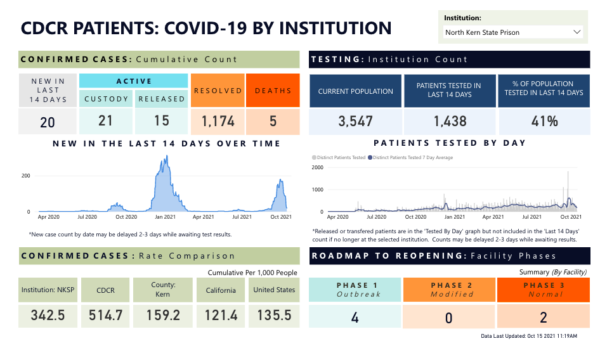
Judge Barmann explained his decision: “What I don’t want to do is I don’t want to put somebody in a situation where there’s something that happens to them that truly is irremediable.” As I said on the radio, this language can act as a dog whistle to COVID deniers, because guess what, long-term COVID and death are what’s “irremediable.”
Stay tuned for more developments in all these cases.
Hallelujah! Judge Tigar Mandates Vaccination for Staff, Guards
Fresh off the news: Given the risk from the delta variant–already fueling a massive outbreak at North Kern – Judge Tigar has finally mandated vaccination for CDCR staff (currently, vaccine rates among staff stand at 40%.) Sam Stanton and Wes Ventreicher of the Sac Bee report:
Rejecting opposition from California officials and the state’s prison guard union, a federal judge on Monday ordered the state to come up with a plan in the next two weeks for mandatory COVID-19 vaccinations for guards, as well as inmates who work outside the prisons.
The order by U.S. District Judge Jon S. Tigar in Oakland follows a hearing Friday over the issue and a recommendation in August by the federal prison receiver overseeing medical care that asked the judge to order mandatory vaccines for guards and staff, with some medical and religious exemptions.
“The question of mandatory vaccines is complex,” Tigar wrote in a 22-page order. “In this case, however, the relevant facts are undisputed. No one challenges the serious risks that COVID-19 poses to incarcerated persons.
“No one disputes that it is difficult to control the virus once it has been introduced into a prison setting. No one contests that staff are the primary vector for introduction. And no one argues that testing, even if done on a daily basis, is an adequate proxy for vaccination to reduce the risk of introduction.”
Tigar noted that since the pandemic began in spring 2020, more than 50,000 California inmates have been infected with coronavirus, and at least 240 have died.
His order would require mandatory vaccines for all workers entering California prisons, all inmates who work outside the prisons and inmates who agree to in-person visits. The judge also wrote that the receiver “shall consider efforts to increase the vaccination rate among the incarcerated population, including whether a mandatory vaccination policy should be implemented.”
The California Department of Corrections and Rehabilitation said in a statement that it was “evaluating the court’s order at this time to determine next steps” and did not agree with the judge’s finding of “deliberate indifference” by officials in their COVID policies.
“We respectfully disagree with the finding of deliberate indifference, as the department has long embraced vaccinations against COVID-19, and we continue to encourage our staff, incarcerated population, volunteers, and visitors to get vaccinated,” the statement said. “Additionally, we were one of the earliest adopters of the COVID-19 vaccine, having rolled it out to vulnerable populations and staff at the end of 2020, and have implemented robust response and mitigation efforts against the pandemic.
“We are also actively working to operationalize the recent California Department of Public Health Order and ensure all impacted staff is in compliance by Oct. 14.
“Currently, 76 percent of the incarcerated population has been fully vaccinated, with 57 percent of staff vaccinated and another 4 percent having received at least one dose. And to date approximately 99 percent of incarcerated people have been offered the vaccine.”
The judge acted after Receiver J. Clark Kelso submitted a 27-page report last month warning of “enormous risks” to the prison population because of the delta variant and noting that only 40% of the state’s correctional officers statewide are fully vaccinated.
In Friday’s court hearing, Kelso added that 11 correctional staffers have died from COVID-19 since his report was issued in August.
A lawyer for the state prison guard union argued against such an order, telling the judge that he did not believe the judge had the authority to issue such an order.
“This is uncharted territory that we’re in in this proceeding,” said Gregg Adam, arguing for the California Correctional Peace Officers Association. “There is no precedent for a court ordering employees to be vaccinated in order to keep their job under any circumstances.”
The union represents about 28,000 state correctional officers and pledged to members last month that it would fight mandatory vaccination orders. The union hasn’t opposed the current regimen, which allows unvaccinated officers to submit regular COVID-19 test results in lieu of proof of vaccination.
“We’ve undertaken an aggressive, voluntary vaccination program and we still believe the voluntary approach is the best way forward,” union president Glen Stailey said in a prepared statement emailed Monday by spokesman Nathan Ballard. “We are looking into our legal options to address this order.”
A Prison Law Office attorney representing the inmates who argued for the order said Monday that the judge’s decision was a “terrific” victory for keeping prisoners safe.
“It provided a very clear, factual basis for the decision,” attorney Rita Lomio said. “It was issued timely, just one business day after the argument Friday, and it adopts the receiver’s recommendation completely.
“It’s pretty much everything we could have hoped for.”
Lomio noted that the order does not set a deadline for the state to come into compliance with the order, instead mandating the receiver and prison officials submit a plan for meeting the requirements of the order within the next two weeks and include a deadline in the plan for when staffers must be vaccinated.
“That’s one area where we’re going to have to continue to monitor to make sure that poor implementation doesn’t gut the mandate,” she said.
Here’s the order in all its glory. Importantly, Judge Tigar fashions the mandate as the remedy for an Eighth Amendment violation, finding that CDCR has acted with deliberate indifference regarding the health and safety of incarcerated people. This is a big victory for incarcerated people, their families, advocates, and lawyers who have fought for this for almost two years.
It’s very late in the game – I wish we hadn’t wasted so many precious months on gentle persuasion efforts at people who cannot be swayed – but it’s better than never. The timing is appropriate – the worrisome North Kern outbreak has been linked to a staff member. Stay tuned for reports on compliance or lack thereof.
Newsom’s Captive Supporters: COVID-19, Sirhan Parole, the Recall, and the Illusion of a Blue State
Tomorrow, the Californians who have not yet voted by mail will participate in yet another recall election. I’ve already spilled enough pixels explaining why I voted no, and why you should do the same. But I do want to say something about the deep ambivalence that prison activists and advocates probably feel around this election. People can and should contain multitudes of contradictions and complicated opinions.
Over the weekend, Bob Egelko of the Chronicle wrote this interesting and insighftul piece about Sirhan Sirhan, now 77 years old after five decades in prison for the murder of Robert Kennedy. Sirhan was recommended for parole by the board,, which means that his case is now on Newsom’s desk. And as Egelko explains (with a little assist from Stanford’s Bob Weisberg and from yours truly), the political calculus is heavily rigged against Sirhan:
“Anybody that has ever walked into my office, you have to walk by photographs of Bobby Kennedy’s funeral procession, those famous train photos,” the governor said, according to a transcript provided by his office. “The first photograph, the only photograph you will see in my office is a photo of my father and Bobby Kennedy just days before Bobby Kennedy was murdered.”
Newsom’s leading opponents in the recall are well to his right politically and would seem equally unlikely to approve Sirhan’s parole. And any decision to release Kennedy’s murderer would surely become a flash point in the 2022 governor’s election.
“I’d be shocked if Newsom didn’t reverse” the parole board’s decision, said Robert Weisberg, a Stanford criminal law professor. Although the governor would have to explain why he believed Sirhan still posed a threat of violence, Weisberg said, he would most likely be “responding to a public view that this guy’s crime was so heinous that he shouldn’t be paroled.”
Egelko is right on the money, as was Jonathan Simon in Governing Through Crime: it is an asset to left-wing politicians to position themselves as tough-on-crime where their supporters have no leverage. This is especially true in California which, as Vanessa Barker explains, is a populist, polarized state. The only two discounts on that front have been recession-era fiscal concerns and riding a popular racial justice wave in progressive cities. And keep in mind that Sirhan is not alone: the entire “Class of ’72′”–the folks whose sentences were commuted after People v. Anderson, including the Manson family members–has been reviled for decades. After the return of the death penalty, the weakening of the parole system, and the politicization of the whole process, the prospects of release for anyone who could peel centrists off the left base became dim. Egelko explains why:
The law allowing the governor to veto parole decisions was passed after courts rejected Gov. George Deukmejian’s attempt in 1983 to block the parole of William Archie Fain, who had served 16 years in prison for murder and rape in Stanislaus County. The Legislature put Proposition 89, a state constitutional amendment, on the ballot in 1988 and it was approved by 55% of the voters.
Even before the ballot measure, convicted murderers were seldom paroled, even after decades in prison. The board has historically approved their release in less than 10% of the cases, and in some years less than 5%, leaving the others to continue serving life sentences.
Gov. Pete Wilson overruled the board about 30% of the time. His successor, Gov. Gray Davis — who declared, soon after his election, that “if you take someone else’s life, forget it” — vetoed all but six grants of parole, just above 1% of the total approved by the board. Gov. Arnold Schwarzenegger rejected about 70% of the board’s parole decisions.
The trends shifted under Gov. Jerry Brown, who overturned the board only about 20% of the time, and so far under Newsom as well.
And warnings of the dangers of paroling convicted murderers do not appear to be supported by the evidence: Between 1995 and 2010, 48.7% of all former prisoners in California went on to commit new crimes after their release, but among the 860 prisoners convicted of murder who were paroled, only five — 0.58% — had been jailed or imprisoned again, according to a report by the Stanford Criminal Justice Center.
“You age out of violent crime,” said Hadar Aviram, a law professor at UC Hastings in San Francisco.
But while Newsom has overseen the court-ordered reduction of the prison population, now at lowest its level since 2006, and has proposed closing two state prisons by 2023, Aviram — author of the recent book “Yesterday’s Monsters: The Manson Family Cases and the Illusion of Parole” — said Newsom’s response to the proposed parole of a Charles Manson follower was a likely indicator of his future decision on Sirhan.
The parole board has repeatedly recommended release of Leslie Van Houten, who was convicted of taking part in two of the Manson family’s Los Angeles-area murders in 1969, when she was 19. While Van Houten has a clean prison record and has earned college degrees behind bars, Newsom said in November that her “explanation of what allowed her to be vulnerable to Mr. Manson’s influence remains unsatisfying” — his second veto of her parole, after two similar decisions by Brown.
“The gubernatorial veto was introduced in 1988 anticipating precisely this scenario,” Aviram said. It was a “power shift,” she said, from “professionals,” such as psychologists and prison counselors who advise the parole board, “toward the limelight of sensationalized, politicized coverage” and changed outcomes.
The upshot of all this: I feel quite bitter. In the last few weeks I’ve seen the people who have ample cause for resenting Newsom–the people whose family and friends are behind bars, facing risk of illness and death because this administration wallowed and waffled on releases while at the same time vigorously defending medical atrocities, indifference and ineptitude in court–unequivocably and firmly doing the right thing, voting “no” on the recall and encouraging everyone they know to do the same. I resent that they are being put in this position. I resent that we are all being put in this position. I resent that a politician whom I deeply admire for what he has done for same-sex marriage and death penalty abolition takes the easy and expedient way–again and again!–whenever someone behind bars is concerned. I resent that incarcerated people and their families are always the sacrificial lambs in these left-versus-right California tumbles, because the right-wing candidates are perceived as much worse. I resent that the incentive structure is always stacked against releasing old and sick people from prison–even though there is compassion and redemption to be gained and nothing to be lost from a public safety perspective. I resent that the people doing the hardest activist work stand to gain absolutely nothing–no sympathy, no consideration, no concessions, no compassion, no fairness–from doing the right thing for everyone else.
In sum, if you feel resolute and at the same time awkward about your “no” vote, you’re not alone. You’re part of a captive support contingent for blue politicians in California–some members of which are literally captive. It is possible to accept that anyone on the replacement list–particularly Larry Elder–would be disastrous as governor, and to respect and admire Newsom as a capable and experienced politician, while at the same time deeply resent the fact that, once again, urgent human rights issues–true life-and-death matters–have been swept under the rug.
How to fix this? Abolish the gubernatorial veto. Diversify parole boards. Change parole from a wacky card game with no rules, which the house always wins, to an instrument of true hope and transformation. But none of this will happen before tomorrow. So, we will dutifully vote “no”, because we are not single-issue dolts, and continue to await the change that never comes.
Parole News & Another Great Review of Yesterday’s Monsters
The COVID-19 crisis is truly driving home one of the main themes of Yesterday’s Monsters: The counterproductivity and cruelty of incarcerating aging, infirm people for interminable periods. I wrote about this on the UC Press blog and have a new piece coming out of the International Criminal Law Review. But better than anything I could write on this is this phenomenal episode of Ear Hustle with Leslie Van Houten, in which her reflective nature and elegant turns of phrase drive home the outlandishness of spending fifty years of one’s life behind bars. I’ve commented on the irony of yet another gubenatorial veto on Van Houten’s release precisely when her prison was experiencing a serious outbreak, and it shows again how the shadow of the past and political hysteria still drive parole outcomes. Highly recommended.
Along the same lines, the new issue of Critical Criminology features a great new review of Yesterday’s Monsters by Rita Shah, author of The Meaning of Rehabilitation and Its Impact on Parole. Here it is, reproduced in its entirety:
Twenty-twenty was a watershed year for conversations around criminal justice reform, abolition, and transformative justice. Calls for change gained public support in ways rarely seen before. The combined ills of COVID-19 and police brutality highlighted issues within the “criminal legal system”Footnote1 of the United States (US) that could no longer be ignored. And yet, one area of the system remains in the background: community corrections. For all the calls to reform or abolish the carceral state, the “Cinderella complex” surrounding community supervision (Robinson 2016) helps maintain these systems as public secrets (Shah 2020). One book published in 2020 that aims to shed light on issues within a part of these systems—parole—is Hadar Aviram’s Yesterday’s Monsters: The Manson Family Cases and the Illusion of Parole.
Aviram’s book makes it clear that parole, particularly parole hearings, must be a part of conversations around criminal justice reform and transformative justice, and she uses an unusual case to do so. As Aviram notes in the Preface and Acknowledgments, she never intended to write a book about the Manson Family. Similarly, many of us never intend to read a book about the Mansons. In this case, however, not doing so would be a mistake. Yes, it is a book about the Manson Family. But it is also not a book about the Manson Family. Aviram deftly uses the story and lore of the Mansons as a vehicle to take a deep dive into the very opaque process of parole hearings and release decisions. Yesterday’s Monsters: The Manson Family Cases and the Illusion of Parole is also an examination of societal views on violent offenses and an exploration of how assumptions and prejudices about those who commit such crimes haunt the US criminal legal system decades after the fact. “The too long, didn’t read” summary for Aviram’s book is: come for the Manson Family cases; stay for the carceral critique.
Aviram’s book is divided into an Introduction and seven chapters. In the Introduction, Aviram provides the impetus for the book: she notes that violent crimes are a key point of analysis because they often lead to dramatic changes in criminal justice policy; she explains why the Manson Family hearings offer a unique window into how parole hearings operate, particularly given the extensive records available; and she describes the notion of parole as a performative space as a way of framing parole hearings. The following two chapters contextualize the analysis presented in the book. Chapter One provides a fantastic crash course on parole, including its purpose, how the role of parole within corrections has changed over the years, and how the parole system operates, including the administrative side of parole and the parole hearing process, as well as how legal cases impact the process. Chapter Two takes a broader look at the California penal system and examines how the return of the death penalty in the late 1970s, the rise of victims’ rights advocacy, and cases such as those involving the Manson Family sowed the seeds for a trifecta of extreme punishments: 1) the death penalty; 2) life without parole; and 3) life through the constant denial of parole or, what Aviram (2020: 40) calls, “life de facto.” These three punishments, Aviram argues, provide the background for two key themes about parole hearings that are presented in the remaining chapters.
The first key theme, the role of narrative in parole hearings, is brought to light in Chapters Three through Six. Narrative plays a role in these hearings in four ways. First, in Chapter Three, Aviram uses narrative analysis to discuss the various stories that were used to explain the Manson Family murders and how the “Helter Skelter” narrative rose to prominence. Aviram expands this analysis in Chapter Four to show how the “Helter Skelter” narrative impacts the Manson Family’s parole hearings and the story that parole board members expect in such hearings. In Chapter Five, Aviram shows how the desire for a specific story by board members impacts parole hearings for all individuals under consideration, not just the Mansons. Finally, in Chapter Six, Aviram introduces the notion of the “Bardo”— the idea that one’s future is predicated on one’s past—and how it can be used to conceptualize the entire process of release to parole.
The analysis presented in these four chapters echoes an oft-repeated line from Hamilton: An American Musical: “Who lives? Who dies? Who tells your story?” In the case of parole hearings, who tells the story and the narrative chosen is the crux for determining who lives and who dies. As Aviram argues, the key to the narrative for all parole hearings is the notion of insight, which seems to be a stand-in for rehabilitation. Like rehabilitation (see Shah 2017), insight seems be a bullshit term as determining whether one has gained insight or is on the road to rehabilitation appears to be the criminal legal system’s equivalent of “I’ll know when I see it.” But this, ironically, requires insight on behalf of the parole board to know what they want to see and the ability to convey that to the individual being considered. Hence, both insight and rehabilitation raise questions about how success is defined and who gets to define it (see, e.g., Heidemann et al. 2015). These questions become key as the notion of “success” seems to be the basis of the narrative the board is seeking, even if that is not what they call it.
Unfortunately, for the individuals involved in the Manson Family cases, the narrative desired is also impacted by the narrative told about the crimes themselves. As Aviram notes, while the narrative that “stuck” was the “Helter Skelter” narrative, two more sympathetic and arguably more accurate narratives—that of a cult and that of common criminals—also exist. Nevertheless, the “Helter Skelter” narrative is the one used against the Manson Family members. In doing so, the parole board members and the victims and their representatives use the narrative to write a book with a predetermined ending, and no matter what the characters do or what the system allows them to do, the book will end the same way. This is made abundantly clear in the story of one Manson Family member, Susan Atkins, who, while literally on her death gurney, was still denied release for fear of her “dangerousness.”Footnote2
Indeed, adherence to the desired narrative—one that focuses on the ability to build a life in prison as expected by the parole board but one which is often difficult to achieve—reveals a frustrating Catch-22. On the one hand, the parole board requires attending programs, many of which do not exist or are not accessible because of housing and work schedules, and it dismisses the sort of self-led programming individuals participate in to try to meet this requirement. Thus, the parole board’s refusal to acknowledge the reality of life in prison is used to undermine attempts at progress and thus deny release. On the other hand, the parole board chides individuals for not obtaining specific job skills. This can lead to an undermining of parole plans—such as the case of Manson Family member Bobby Beausoleil, who showed evidence that obtaining a well-paying job is possible—which also leads to a denial of release. In other words, the narrative is set, and parole board members utilize their knowledge in ways that ensure the ending they desire.
For individuals seeking parole, the parole board’s preferred narratives also raise real questions about when or even if it possible to become an “ex” or “former,” whether it be offender or incarcerated individual. Individuals before the parole board are made to re-tell their histories over and over again, and the parole board relies heavily on the initial conviction and past infractions, risk assessments, and therapist notes when making their decision. This makes it virtually impossible for those eligible for consideration to ever become more than who they were. The “moral memory” holders present at the hearings—the prosecutors, victims, and victims’ representatives—certainly do not help in creating new narratives about the present or future.
The second key theme, the notion of the “Bardo,” appears in Chapters Six and Seven. As noted above, the concept of the “Bardo” is introduced in Chapter Six as an analogy for how one’s future is dependent on one’s past rather than one’s present. In the concluding chapter, Chapter Seven, Aviram continues this discussion, noting that the “Bardo” is a liminal space between death and rebirth. For the parole hearings, the “Bardo” is “a cycle between hope and disappointment, preparation and hibernation, action and inaction, self-improvement and self-assessment, in which inmates have to participate and lawyers act as ‘hope managers’” (Aviram 2020: 206). This cycle creates a situation where, at least during the parole hearing, individuals eligible for consideration remain stuck in a liminal space, not fully incarcerated but not yet free, both human and yet not-human. While Aviram focuses on parole, the concept of “Bardo” and analysis presented point to two larger issues within the criminal legal system as a whole: 1) the notion of the system as “effective”; and 2) the challenge of reentry to society post-release.
First, the “Bardo” raises questions about how effectiveness is measured by the parole board members and by other aspects of the system. The parole board, as Aviram highlights, focuses on a particular rationale for its decisions: an individual who is being considered for parole and has successfully completed programs and/or met the amorphous requirements the board sets for release are due solely to the successful nature of the incarceration experience. But those who fail—even when the failure is due to the systematic problems of incarceration—fail solely because of their own (in)ability to obtain proper insight and meet the unattainable requirements. In other words, the parole board deeming someone suitable for release is a testament to the idea that “prison works,” but denying release is a testament to the parole board’s role in maintaining public safety. The parole hearings are a classic case of the house always wins. But this faulty logic is precisely the logic that enables the “Bardo” to survive. The liminal space between death in prison and rebirth in society is maintained not through any real notion of making the right decisions, but through the illusion of prisons as a “correcting space” and “public safety” as a catch-all justification for carceral spaces—two terms that arguably create yet another “Bardo” and that help the board members justify their roles.
In reading Aviram’s analysis, I would argue that the notion that the house always wins can also be applied to other aspects of the criminal legal system. For probation and parole supervision, for instance, successfully navigating and being discharged from supervision is due entirely to the effectiveness of supervising agents. Getting revoked, however, is entirely the fault of the individual and a sign of the system maintaining public safety regardless of larger social factors at play. Again, the house wins. For policing, a drop in crime rates is a sign of the effectiveness of policing. A rise in the crime rate is a sign that there is not enough policing. Again, the house wins. In other words, the entire criminal legal system is a “Bardo”—one that holds society in between death (framed in language that evokes fear of crime critiques) and rebirth (framed in the language of public safety). And the language of the “Bardo” is used to maintain and justify the system’s existence and assure its continuation.
The second issue Aviram’s discussion points to is the “Bardo” of parole and reentry, more broadly. Parole, itself, is a liminal space—one that functions as a state-run reentry program: one in which an individual is free but not really free. While on parole, the conditions one must follow and the fear of revocation ensure the individual is constantly aware that he/she/they is/are still held by a sentence of the state and a reminder that the system is designed to uphold the notion that those under supervision are inherently bad and destined to fail (McNeill 2019). Furthermore, collateral consequences continue to impact them (see, e.g., Brisman 2004, 2007; Williams and Rumpf 2020). In fact, unless one’s criminal history is purged completely, all individuals with a record remain entangled in a lifelong “Bardo”: they are both in society but not of it.
Combined, the two themes regarding the role of narratives and the implications of the “Bardo” show that those sentenced to life with the possibility of parole are damned if they do and damned if they do not. Aviram highlights how life with the possibility of parole is, indeed, “life de facto”: it is essentially a life without the possibility of parole, which is, in turn, a stand-in for the death penalty. What emerges is a reminder that the system functions exactly as it was meant to. While Aviram offers suggestions for improving the parole hearing process, the analysis raises serious questions as to whether parole is a system worth saving. Thus, while Yesterday’s Monsters: The Manson Family Cases and the Illusion of Parole does not explicitly support abolitionist arguments, it could be used to do so. But that is not its only use. Aviram’s book is also a testament to the value of historical, narrative, and qualitative analysis. Scholars and students wishing to learn more about these methods, about parole, or about how to tackle the behemoth that is the criminal legal system “Bardo” will find this book a useful read.
Many thanks to Rita for this careful read and excellent review–and especially for the useful zinger “the house always wins”, which perfectly captures how parole works and what we need to fix.
The Staff Is the Problem, Contd.
I know I sound like a broken record, but it’s not me–it’s the news. Not only are the San Francisco Sheriff Department’s employees threatening resignation over the vaccine mandates, but CCPOA, possibly the most bad-faith actor in the whole COVID-19 prison crisis, is now fighting the state vaccine mandate in Sacramento. The UCLA COVID-19 Behind Bars Data Project summarized this problem in a data-rich blog post, and the danger is plain and evident from this modeling piece in the Lancet. I’ve already spent considerable time discussing this here and here among many other places. My newest take on this is on KCBS. My position on this can be summarized in seven points:
- Adopting exactly the opposite position than the one they should on vaccination is part and parcel of the pandemic approach of custodial staff and their approach stinks from the top. It harmonizes with their failure to mask, mockery of the residents’ fears, and disgusting fomentation of fear and disinformation.
- The problem is dual: CCPOA’s political capture as well as the COVID denialism of the rank and file. We can only speculate about Trumpism among the ranks based on what we know from other law enforcement agencies.
- As the dismaying San Francisco story demonstrates, what happens at CDCR mirrors what happens in the counties, where things are even worse b/c the incarcerated incarcerated population’s vaccine rates are considerably lower than in state prisons (a more transient and considerably younger group).
- Neither the governor’s office nor the courts have done enough to bring about acceptable staff vaccination rates, and have instead focused their energy on giving bonuses, consulting with gentle persuasion experts, and lavishly complimenting CCPOA for even deigning to show their faces in federal courts. Our executive and judicial branches must share in this shame.
- Take it from my colleague, Dorit Reiss, who specializes in vaccine law: There is no valid legal or constitutional argument correctional officers can lob against the vaccine mandate. CCPOA and the Sheriff’s Department have not got a leg to stand on.
- Anyone unwilling to do their part to prevent a medical catastrophe among the people they are in charge of is not a good fit for a custodial job.
- Finally, I’ve heard countless variations on the theme of “it’s complicated”, “we have to remunerate/reward them instead”, and “how can we attract people to work for us/avoid dangerous vacancies if we impose a vaccine mandate”: If correctional institutions find it impossible to recruit enough people who can be conscientious about the vaccine, the conclusion to draw is that we should not incarcerate as many people as we do.
Christ, These Parole Officers!
Today brings a special offering from the Tenth Circuit: Janny v. Gamez exposes (and finds unconstitutional) some religious coercion in reentry programming. The facts:
Mark Janny was released from jail on parole in early 2015. His parole officer, John Gamez, directed Mr. Janny to establish his residence of record at the Rescue Mission in Fort Collins, Colorado, and to abide by its “house rules.” After arriving at the Mission, Mr. Janny learned he had been enrolled in “Steps to Success,” a Christian transitional program involving mandatory prayer, bible study, and church attendance. When Mr. Janny objected, citing his atheist beliefs, he alleges both Officer Gamez and Jim Carmack, the Mission’s director, repeatedly told him he could choose between participating in the Christian programming or returning to jail. Less than a week later, Mr. Carmack expelled Mr. Janny from the Mission for skipping worship services, leading to Mr. Janny’s arrest on a parole violation and the revocation of his parole.
That this offends the First Amendment should be obvious–but apparently wasn’t to the parole officer. And I think it would be a mistake to view this through a narrow prism of preferential treatment for evangelical Christianity. I say this because, in Yesterday’s Monsters, I devoted a considerable amount of the narrative to the way the parole commissioners treated Susan Atkins, Bruce Davis, and Tex Watson, all of whom are born-again Christians. I wrote:
A charismatic, proselytizing religion, characterized by the consistent responsibility to offer ministry to others and draw them closer to a personal relationship with their Savior. Offering testimony in this religious context is surprisingly similar to expressing and performing “insight” before the Board. The act of Christian testimony often includes references to previous life, and maximizing one’s bad acts prior to conversion plays an important rhetorical role in highlighting the magnitude of the transformative experience. It can be analogous to the “I once was blind, but now I see” narrative of insight, with the important distinction that the insight is specifically religious. But for the Board, accepting a religious conversion wholesale is a dangerous proposition. The hearing transcripts of Davis, Watson, and Atkins demonstrate various ways in which the Board is uncomfortable with the role of religion in the inmates’ lives: it is out of the Board’s scripted plan for the inmate; it is insincere; or, it is too sincere for the prison environment.
As I show in the narrative, the Board flunks Susan Atkins for ministering to her fellow inmates (literally a captive audience–but offering testimony is part of the mandates of evangelical Christianity); Bruce Davis for preferring the programs he runs in the prison to the official psychological counseling and for having “replaced Manson with Jesus”; and Tex Watson for bonding with a relative of his victims over their shared faith. So I don’t think what’s going on here is some sort of bias in favor of Christians.
Instead, it makes more sense to see this through the prism of the postrecession absence of proper rehabilitation and reentry programming. Into the void caused by states’ ineptitude and austerity stepped organizations that retained their funding base, and it’s not particularly surprising that, in this deeply religious country, many prison ministries are religious.
Back in the 1990s, I remember talking to a prison reentry pioneer in Israel who explained that he’d partner with anyone who offered a positive path of redemption: a secular kibbutz, an ultra-Orthodox yeshiva, a general contractor offering construction jobs, whoever had something to bring to the table. And I think it’s a great approach–provided that people like Mark Janny, who want their reentry without a side helping of accepting Jesus as their personal savior, have a choice.
Delta in Prisons and Disturbing Staff Vaccination Rates
As many of us experience despair and frustration with the virus’ persistence and wonder what fresh restrictions, closures, and infighting 2021 will bring, here’s a glance at how this has played out in California prisons. As per CDCR data (now compiled for your convenience, in collaboration with the COVID in-custody project, on this blog) CDCR has 159 new confirmed cases in the past 14 days, for a rate of 160 per 100,000. For comparison, CA has a rate of 258 new cases per 100,000 in the past 14 days. There are three new outbreaks: SOL (3) PBSP (11) and PVSP (9). A major outbreak is occurring at SCC (111. cases.) Against this backdrop, CDCR as a whole has a net population increase of 42 since last week (presumably jail transfers.)
Before talking about what is going on, let’s take a glance at the vaccination status. The vast majority of the incarcerated population is incarcerated – just a bit over 50% of the staff is, and no sign that anyone – Judge Tigar, the Governor, the Attorney General – has plans to require vaccination (for comparison’s sake, my workplace, like all campuses of the University of California, requires proof of vaccination.)
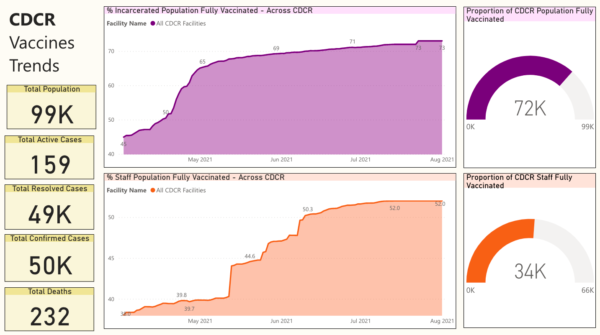
It’s important to exercise caution when talking about this. We are hearing again and again that this new plot twist, robbing us of our way of life, is a plague driven by unvaccinated people and the solution is to vaccinate. Newspapers are fomenting an enormous amount of outrage against the unvaccinated and, with everyone’s nerves already frayed, it’s easy to view this group as a monolith. I worry a bit about this facile story; it turns out that, in Israel, half of the infections are among vaccinated people and the government has started offering a third booster to older people, which suggests that the vaccine’s protection wanes over time. Still, given our quaratinist approach to managing healthcare in prisons, it’s hard to argue with the fact that the virus does enter prison from somewhere, likely through staff, and that the rates of people refusing to take a free, accessible, and medically proven prophylactic among staff are significantly higher than in the general population. As the UCLA COVID Behind Bars Data Project has shown, this is a disturbing nationwide trend:
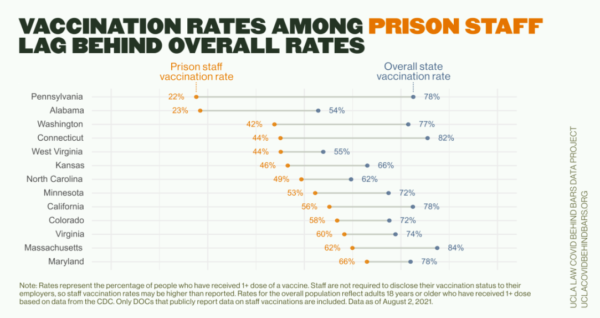
What we’re seeing is no more than what has been the case since the beginning of this: I’ve documented again and again the ways in which the problem with COVID management has been the staff, particularly custodial staff. Just like the Governor has demurred about the scale of releases that would protect elderly, infirm people from COVID, he has demurred about requiring staff to vaccinate. A recurring theme at the Plata hearings has been the effort to treat staff with kid gloves, consult experts on methods of gentle persuasion, congratulate CCPOA for the simple act of even deigning to show up at the case management conferences–in short, do anything except impose a state mandate. The Attorney General has put so many of his employees to work on opposing releases and relief, in the Plata and San Quentin cases, that one might ask if anyone’s even been tasked with considering the legality of a CDCR vaccine mandate.
It’s hard not to be cynical about this when we hear that CCPOA is the largest organizational donor to Newsom’s anti-recall campaign, just recently cutting him a check for $1.75 million (for a total of $4.1 million) after receiving bonuses. CCPOA has been a major political player in California for ages, and has been actively striving to become a political force again even though its traditional issues have become muddled (crime rates are low and the discourse about criminal justice has shifted.) I want to be clear about two things. First, I oppose the recall and will personally vote against it. I think the alternative is much worse than Newsom–even as I find myself unmotivated to donate or volunteer to help the person who presided over the worst prison medical disaster in U.S. history. Second, we have no proof that CCPOA’s support of his campaign is directly related to the waffling about vaccine mandates (and is far more closely tied to bonuses for custodial staff.) But at the very least, given how much we know about how CCPOA treat their enemies, this suggests that CCPOA perceive Newsom as an asset. Also, remember – Newsom desperately needs the CCPOA’s support as he loses ground in the recall battle. So, even though I’m not saying that this is payoff for his staff vaccination policy (or non-policy,) it almost certainly means we won’t be seeing a vaccine mandate.
This might be what CCPOA rank-and-file members want, but it’s not what they need. Nationwide–and in California–staff infection rates are considerably higher than the rates in the general population (in California, almost twice as high.)

The story of CCPOA’s engagement with this crisis is, therefore, complex. The union is completely politically captured, for sure; it does not defend the rational interest of its members, for sure; but “rational interest” and actual interest are not the same thing. In evidence everywhere are COVID denialists who accept their diagnosis only when it’s much too late. Because nobody has collected reliable data on political opinions among prison guards, we can only guess how much of this reluctance among prison staff reflects the wider phenomenon of Trumpist prevalence within law enforcement. If it does, I expect the chances of them changing their minds even as their colleagues fall ill are probably similar to the chances of Newsom, now their political protégé, protecting them from themselves through a vaccine mandate.
Applying Lessons from Circle Swimming to Prison Advocacy
The number of letters, emails, calls, etc., I got after I published this was truly moving overwhelming. It looks like many advocates and activists share a sense of immense exhaustion and feeling unwell and many of us want to get better. For me, as you know, this journey includes total commitment to a whole-food, plant-based diet and to daily outdoor exercise: running, cycling, and swimming. The last of these is the only one at which I’m a veteran; before I semi-retired from the sport in 2016 I was an open water marathon swimmer. These days, for practical reasons (little boy and full-time job=> no time to schlep to the bay, acclimate, and then pour hot tea down my gullet to defrost myself) I swim for no longer than an hour in one of our city pools.
We don’t have many public pools; the ones we have are beautiful and the staff is great, but there is a serious nationwide lifeguard shortage. This means opening hours are extremely limited and the pools get crowded. It’s become rare to have only one person to split a lane with, let alone have the whole lane to yourself. At one of the pools I swim in, there are regularly at least five people to a lane. In the other it’s about three and four. Because these are strangers, not masters teammates, the lanes aren’t calibrated to people’s exact pace, and the fast/medium/slow lane categories are completely arbitrary. Bottom line – I regularly end up in a lane with people who swim either faster or slower than me. Many of the slower folks are delightful people who stop at the pool end to let you pass them, but unfortunately not everyone has the proprioception or the humility to do it. And so, sometimes I get stuck behind folks who really should know better and who make it impossible to pass them (I should say – because I know firsthand the aggravation this causes, when I swim with faster folks I’m hyperconscious of them and let them pass at every opportunity!).
I’ve narrowed the possible coping strategies to five, and some of them are better than others:
- Do nothing and fume. Or, do nothing and slap the water in rage, or kick a little extra hard to vent your frustration. This does not help – not at all – and essentially the only person I punish by marinating in my anger over this is myself.
- Appeal to higher authorities, namely, to the lifeguards and ask them to reorganize people by lane. This is kind of drastic – I’ve never done it myself nor have I seen it done in city pools. At some private clubs I’ve swum in, the lifeguards are experts on tactfully doing this, but it also carries the frustration of dealing with your problem through third parties rather than practically resolving it yourself.
- Change lanes mid-lap and swim back. Here’s how this works: You swim behind the slow person for as long as conceivably possible (to earn yourself some good laps later) and then, right before the wall, shift to the other lane and swim away fast. This obviates the need to confront the other person in any way, and if they are clueless it won’t upset them, either, but you could run into problems confusing the slow swimmer or other swimmers and, in some situations, could be a bit dangerous.
- Aggressive mid-lap pass. This is an emergency move, and an undesirable one, but sometimes people don’t leave you much choice. You carefully check if there’s anyone coming toward you in the opposite lane (i.e., that the other swimmers are already behind you) and them quickly shift to the left lane and beat the slow swimmer to the wall. Beyond the obvious risk, this is also a physically aggressive move and I would not be surprised if it upset and scare the slower swimmer.
- Confront the person at the wall, either through body language (touch their foot lightly, shift to the middle of the lane to block their turn) or actually say “can I pass?” I’ve never seen anyone manifestly refuse to let another person pass after a confrontation, but for a lot of people who look forward to their pool time as their happy place, it could be several laps before the work out the nerve to do it (now that I think about it, I bet there are cultural differences in pool behavior between different countries).
The wisdom we should all cultivate (I’m working on this myself, yo, so don’t think I’m anywhere close to circle swimming nirvana!) lies in deciding which of the five approaches is appropriate for each situation. For example, I think that option 1 is only good when you have a few minutes of cooldown before your workout is over, and then it’s best to channel your frustrations into working on your butterfly or backstroke or do a couple of leg laps without fins, which slows you down coming into the wall. Option 2 is only good when you’re at a pretty hierarchical or at a pretty expensive facility. As to options 3-5, their desirability depends on who you’re dealing with, and here it’s worth remembering that you don’t actually know the person from Adam, and that behind the cap and goggles, “slow-ass” might actually be a lovely person on whom you’re unfairly projecting the frustrations of your day. It’s quite possible to choose the wrong strategy and add unnecessary stress to what should be a blissful hour for everyone–which is where self-compassion and compassion for others comes in, bigtime.
I think about this stuff a lot when I’m in the water, and a couple of days ago, while discussing this with a friend, I realized that these ways of handling conflict with someone you don’t know have recurred elsewhere in my life, especially in the context of prison advocacy. As I work on our book in progress about COVID-19 in California prisons, I’m realizing that a lot of stuff has been happening, at the state and at the county levels, behind the scenes, and while we were privy to the horrific outcomes of all this through the information we got from our incarcerated friends and family members, we were not exactly privy to the inner workings at CDCR or at the Receiver’s office. We know that they paid no heed to the AMEND report, but did they consult with anyone else? It seemed not from the Quentin litigation, and it seems not from the Plata litigation, but surely not everyone who works there is pure, unadulterated evil, and we need better information about internal disputes and conflicts on how to manage this. We know, for example, that the rank-and-file physicians at Quentin were clamoring to save lives (I’ve spoken to prison workers and many of them are decent, conscientious folks who have had a horrific time for the last year and a half.) We also know that various county jail officials worked extremely hard to make vaccination available to their population (this I know firsthand because they consulted me, and they impressed me as being decent people who were well aware of their responsibilities.) I actually don’t know, and have no way of knowing, whether the top brass at CDCR, CCHCS, and CCPOA sleep well at night. And the problem is that the best approach to getting this pandemic under control as numbers in prison are beginning to rise again depends a great deal on understanding these people and where they come from, and on figuring out how to best work with them, around them, or against them.
Over the course of this struggle, I had some experience doing variations on all of these themes. The litigation, of course, is full of animosity; all the media work, especially the press conferences and the news editions, was also highly confrontational, on purpose. By contrast, I got to collaborate with Orange County officials on producing their vaccine advocacy video because there were people there who were trying, in good faith, to save lives, and it was worth working with them. And in introducing the AMEND FAQ into prisons and our videos recorded by formerly incarcerated folks, we sought to work around CDCR to raise vaccine literacy behind bars by providing sources that our friends and neighbors inside could completely trust–thus working around CDCR (and, to be honest, counting on smuggled cellphones to do the work.)
In order to draw more careful lessons about how I’m going to do advocacy in the future, I need more complete information on which of these strategies worked and which didn’t – and why. For now, I’m providing some help in the form of a wonderful partnership with the Covid in-Custody Project, spearheaded by the unfailingly superb Aparna Komarla (read her recent and worrisome stories on the Davis Vanguard COVID page.) From now on, this blog will host all the data collected by the Covid in-Custody Project at this link, where you can get information about CDCR as well as several jails. Look for a post on resident and staff vaccine rates soon.
My heart is still very much in this battle, even as my body, mind, and spirit needed a health reset–I’m not constantly on twitter or facebook but I still care very much about what’s going on and am figuring out ways in which I can be optimally useful in this fight. In the meantime, if you swim at a city pool, in the name of all that is holy, please let faster swimmers pass you at the wall.

